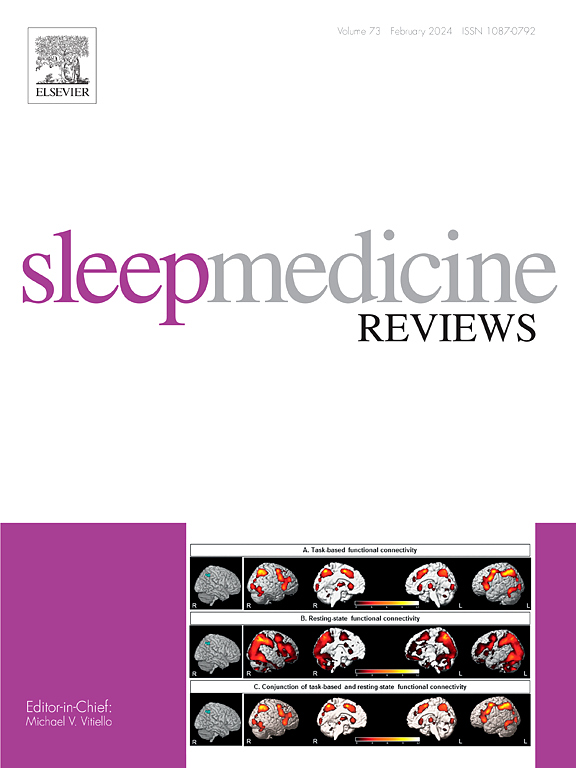Diagnostic accuracy of machine learning algorithms in electrocardiogram-based sleep apnea detection: A systematic review and meta-analysis
IF 9.7
1区 医学
Q1 CLINICAL NEUROLOGY
引用次数: 0
Abstract
Sleep apnea is a prevalent disorder affecting 10 % of middle-aged individuals, yet it remains underdiagnosed due to the limitations of polysomnography (PSG), the current diagnostic gold standard. Single-lead electrocardiography (ECG) has been proposed as a potential alternative diagnostic tool, but interpretation challenges remain. Recent advances in machine learning and deep learning technologies offer promising approaches for enhancing the detection of sleep apnea through automated analysis of ECG signals. This meta-analysis aims to evaluate the diagnostic accuracy of machine learning (ML) and deep learning (DL) algorithms in detecting sleep apnea patterns from single-lead ECG data. A comprehensive literature search across multiple databases was conducted through November 2023, adhering to PRISMA-DTA guidelines. Studies that included sensitivity and specificity data for ECG-based sleep apnea detection using (machine learning/deep learning) ML/DL were selected. The analysis included 84 studies, demonstrating high diagnostic accuracy for ML/DL algorithms, with pooled sensitivity and specificity of over 90 % in per-segment analysis and close to 97 % in per-record analysis. Despite strong diagnostic performance, variations in algorithm effectiveness and methodological biases were noted. This meta-analysis highlights the potential of ML and DL in improving sleep apnea diagnosis and outlines areas for future research to address current limitations.
机器学习算法在基于心电图的睡眠呼吸暂停检测中的诊断准确性:系统回顾和荟萃分析
睡眠呼吸暂停是一种影响10%中年人的普遍疾病,但由于目前诊断金标准多导睡眠图(PSG)的局限性,它仍未得到充分诊断。单导联心电图(ECG)已被提议作为一种潜在的替代诊断工具,但解释方面的挑战仍然存在。机器学习和深度学习技术的最新进展为通过自动分析ECG信号来增强睡眠呼吸暂停的检测提供了有前途的方法。本荟萃分析旨在评估机器学习(ML)和深度学习(DL)算法在从单导联心电图数据检测睡眠呼吸暂停模式方面的诊断准确性。遵循PRISMA-DTA指南,在2023年11月之前对多个数据库进行了全面的文献检索。选择包括使用(机器学习/深度学习)ML/DL进行基于ecg的睡眠呼吸暂停检测的敏感性和特异性数据的研究。该分析包括84项研究,显示ML/DL算法的诊断准确性很高,每段分析的总灵敏度和特异性超过90%,每条记录分析的总灵敏度和特异性接近97%。尽管有很强的诊断性能,但注意到算法有效性和方法偏差的变化。这项荟萃分析强调了ML和DL在改善睡眠呼吸暂停诊断方面的潜力,并概述了未来研究的领域,以解决当前的局限性。
本文章由计算机程序翻译,如有差异,请以英文原文为准。
求助全文
约1分钟内获得全文
求助全文
来源期刊

Sleep Medicine Reviews
医学-临床神经学
CiteScore
20.10
自引率
3.80%
发文量
107
期刊介绍:
Sleep Medicine Reviews offers global coverage of sleep disorders, exploring their origins, diagnosis, treatment, and implications for related conditions at both individual and public health levels.
Articles comprehensively review clinical information from peer-reviewed journals across various disciplines in sleep medicine, encompassing pulmonology, psychiatry, psychology, physiology, otolaryngology, pediatrics, geriatrics, cardiology, dentistry, nursing, neurology, and general medicine.
The journal features narrative reviews, systematic reviews, and editorials addressing areas of controversy, debate, and future research within the field.
 求助内容:
求助内容: 应助结果提醒方式:
应助结果提醒方式:


